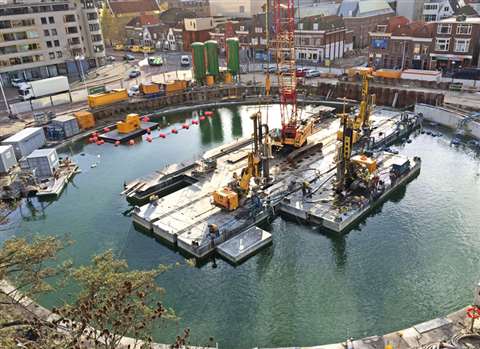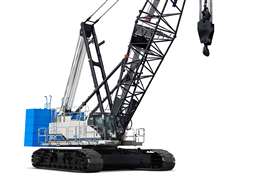Foundations: Ground-breaking work
20 July 2016

Foundations jobs can take many forms, but new technology is concentrating on the usual elements of efficiency, safety and an ability to operate wherever the work is needed – however tight the space may be.
Construction work is said to be well underway for the reconstruction and deepening of the Port of Durban, South Africa, as BSP’s specialised equipment proves an important part of the project. The Port of Durban is South Africa’s largest break-bulk and dry-bulk handling precinct in the Transnet ports system, which has been developed in phases since the early twentieth century.
To carry out the piling operation, the contractors on the project used two BSP hydraulic impact hammers. First, a CG240, with a 16 tonne dropweight, was suspended from a Kobelco 180 tonne crawler crane and mounted on a 40 m by 15 m floating barge, drove the 27 tonne king piles. Then, a suspended CX85 with a 7 tonne dropweight was used to drive the sheet piles and form the combination wall.
Prior to installing the piles, BSP said it carried out an important modification to its CG240 hammer. It said it involved having legs fitted rather than a pile sleeve which reduced the overall weight. It also enabled the hammer to drive the king piles while avoiding any clash with the pile template, which it said had to be kept in place until driving was complete.
The wharf covers 120 hectares and includes 15 berths that are collectively able to handle over 7 million tonnes a year. BSP said the development will ensure that the infrastructure will be operational for the next 50 years as well as catering for the newer generations of vessels using the port’s facilities.
Following extensive assessment on the condition of the Maydon Wharf quay wall at the Port, it was found that seven of the 14 berths were in a critical condition and in danger of collapse.
This port project forms part of a larger R 307 billion (US$ 19.83 billion) investment plan to upgrade and expand Transnet’s railways, ports and pipelines between 2013 and 2019.
Another important project is being carried out by Trevi Spa, a division of the Trevi Group which specialises in special foundations and consolidation of land. The company was awarded a contract for the maintenance and safety of the Mosul Dam in Iraq.
The preparation and signing of the contract, worth € 273 million (US$ 310.02 million), took place under the supervision of the Iraqi Ministry of Water Resources (MWR).
The award follows an international tender issued in October 2015, which followed an emergency procedure due to the critical situation of the dam.
The Mosul Dam is an earthfill dam located on the Tigris River, about 60 km north-west from the city of Mosul. The dam, built in the first half of the 1980s, is a multipurpose project conceived for irrigation, flood control, water supply and hydropower generation.
The contract comprises the repair of manufactured structures and grout injections, which are aimed at repairing the grout curtain.
Furthermore, Trevi will install two rows of holes aligned with the dam, which will be grouted with mixtures able to intercept and close fissures and voids deriving from dissolution phenomena. Due to the location of the soluble layers, Trevi will execute and inject holes up to a depth of 200 m.
For the drilling and grouting, Soilmec SM-5 rigs will be used, while Soilmec SM-16 rigs with long stroke will be used for surface interventions.
In to the new launches by companies, Liebherr has brought out a new hydraulic free-fall H 10 L hammer, which is said to be suitable for tough piling operations with a large radius.
The H 10 L is the first hydraulic free-fall hammer developed and manufactured in-house by Liebherr, and is currently the largest model of three in the new series and has a maximum impact energy of 225 kNm.
Key advantages of the attachment include the modular weights, where the hammer can be perfectly adapted to the respective piling requirements, said Liebherr. It is also said to be extremely efficient as well as user-friendly in terms of transportation and maintenance. At the same time, the pile helmet is soundproof in the standard version.
The control is integrated in the system of the Liebherr basic machines, which Liebherr said allows for better adjustment in accordance with the respective conditions which therefore ensures more efficient operation. In addition to the LR 1300 piling rig, the duty cycle crawler crane HS 895 HD can also be used as a basic machine. Only a slight modification is required with both machines. The hammer can be operated directly from the on-board hydraulic system, meaning no additional power pack is required.
The leader elements of Liebherr’s LRH 600 piling rig include easy and quick assembly of pin connections. A high degree of stability is ensured through the lattice boom design with the kicker also being secured via supporting tubes at the boom head. Two compensating cylinders ensure that the leader always remains parallel to the uppercarriage, which the company said provides maximum transmission of the torque. Inclination and radius can be adjusted using another pair of cylinders.
The LRH 600 achieves an effective working length of 51 m and a maximum radius of 15 m. inclinations of up to 14° backwards and 9.5° forwards are also possible. The pull force extends to roughly 120 tonnes.
Movax has also launched a range of new products this year, including the DH-20 and DH-30 piling hammers.
Movax DH-20 and DH-30 piling hammers are described as excavator-mounted, hydraulic impact-type hammers for driving load-bearing piles or assisting in sheet pile driving. The piling hammers can be flexibly mounted onto the excavator or when greater depths are required on an excavator mounted leader mast.
The key features include its suitability for different site conditions, its availability in different models to meet a wide range of piling needs and its suitability for a wide range of piles including sheet piles, H-piles, tubular steel piles and more.
The piling hammers are also excavator mounted or excavator-leader-mast-mounted, which are designed to work on a standard excavator with normal auxiliary hydraulics. They are also equipped with Movax Control System (MCS), which the company says gives accurate control, safe, flexible and easy operation.
The company has also launched its new Movax EML-12, which is said to be a Leader Mast for piling applications with 12.3 m of effective leader length. Movax said the EML-12 is ideally suited for different type of driven piles, preaugering or different techniques of cast-in situ piles.
The EML-12 can be mounted onto multiple different crawler excavator bases, as piling specific hydraulics and winches are integrated to the Movax leader mast itself. The company also supplies a full featured controlling and monitoring system. The mast is easily transported from site to site, as it can be folded down to size.
Another interesting new launch from Movax is the M-logbook which is a documentation and reporting tool, providing essential data related to piling works.
The piling information collected by the Movax Control System (MCS Pro) is stored in the system’s excavator module. The information is then copied onto a USB-memory drive and transferred to a PC equipped with the M-logbook software for further analysis. Data concerning site and pile information can easily be added and ready-made reports – including both measured and calculated data – provide essential information about the piling work, said Movax.
Pile Dynamics, meanwhile, said an important part of bored pile/drilled shaft construction is the cleaning and inspection of the bottom of the hole for cleanliness, prior to the placement of reinforcement and concrete.
It said that once drilling is complete, any material unsuitable for end bearing support is removed. Bottom inspection is then performed, often by lowering a camera down the bore hole, a procedure that it said gives a rough idea of the thickness of any debris left at the bottom.
The company’s new launch – SQUID (Shaft Quantitative Inspection Device) – is said to be an alternative to the camera-based visual inspection of the excavated shaft base. The device assesses cleanliness by measuring the thickness of the debris or non-competent material remaining at the shaft base, and can also provide a quantitative evaluation of the strength of the bearing layer.
The company added that a drill stub column adaptor allows for a quick pinned connection to the Kelly bar of any drill rig. The SQUID body includes three retractable contact plates attached to displacement transducers, and one instrumented cone penetrometer for each contact plate. The penetrometer cones move through the debris layer and into the bearing material under the weight of the Kelly bar and measure pressure, while the transducers measure displacement.
The device’s body connects by cable to a wireless transmitter at the edge of the borehole, where the transmitter then sends pressure and displacement data to the SQUID Tablet.
The wireless data transmission to the tablet – where data is visualised - then allows for the person holding it to be positioned at a safe distance from the borehole. The SQUID Tablet displays, among other information, the depth of the non-competent layer and the maximum penetrometer cone tip pressure, said Pile Dynamics.
Ditch Witch has introduced the SK850, a new mini skid steer which has been designed specifically for digging foundation trenches.
The machine can cut to a width of 410mm and a depth of 910mm thanks to a specialised heavy-duty trenching chain attachment, powered by a 28kW diesel engine.
Ditch Witch said the SK850 created cleaner, more consistent trenches than an excavator could, and in less time, and added that it was more compact than many excavators, so was better suited to cramped and confined sites. The SK850 can trench from either a centreline or offset position, which means it can dig next to obstructions.
The SK850 carrier itself is the Ditch Witch’s most powerful mini skid steer to date. The company said it offered more ground clearance than other mini skid steers in its class and included fuel-saving features such an auto-throttle – incorporated into the new LCD display – which reduced engine throttle when there was no load on the engine.
And US crane manufacturer Link-Belt has introduced the TCC-500, which has joined the 70 tonne capacity TCC-750 and the 100 tonne capacity TCC-1100 to complete the line-up of Link-Belt telescopic boom crawler cranes.
The TCC-500 has a four-section, full-power boom and has a standard counterweight package of 11.3 tonnes. The model can be transported in most countries, while staying under 45.5 tonnes. It is powered by a Stage IV Cummins QSB engine. A Stage IIIA version is also available.
The company said the TCC-500 had a variable displacement piston pump package, which was designed to provide “positive and precise control” with independent or simultaneous operation of all crane functions, like when using an auger or pole claw attachment. It said, “The TCC-500 can also hydraulically extend its tracks for three working track gauges, including fully extended, intermediate and fully retracted.






